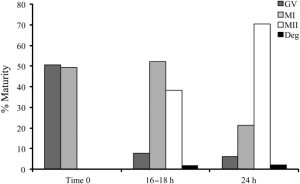OBJECTIVE
Can amino acid profiling differentiate between human oocytes with differing competence to mature to metaphase II (MII) in vitro?
CONCLUSIONS
Oocytes which remained arrested on the germinal vesicle (GV) stage after 24 h of in vitro maturation (IVM) displayed variations within the depletion/look of amino acids in contrast with oocytes which progressed to MII and patient age, infertile prognosis and ovarian stimulation regime considerably affected oocyte amino acid turnover throughout IVM.
BACKGROUND
Amino acid profiling has been proposed as a way which may distinguish between human pronucleate zygotes and cleavage stage embryos with the potential to develop to the blastocyst stage and implant to provide a being pregnant and people who arrest. Most just lately, the amino acid turnover by particular person bovine oocytes has been proven to be predictive of oocyte developmental competence as indicated by the gamete’s capability to bear fertilization and early cleavage divisions in vitro.
METHODS
The research was performed between March 2005 and March 2010. A complete of 216 oocytes which had been on the GV or metaphase I (MI) levels on the time of ICSI had been donated by 67 sufferers.
METHODS
The analysis was performed in college analysis laboratories affiliated to a hospital-based infertility clinic. Oocytes had been cultured for 24 h and the depletion/look of amino acids was measured in the course of the remaining 6 h of IVM. Amino acid turnover was analysed in relation to oocyte meiotic development, patient age, illness aetiology and managed ovarian stimulation regime.
RESULTS
The depletion/look of key amino acids was linked to the maturation potential of human oocytes in vitro. Oocytes which arrested on the GV stage (n = 9) depleted considerably extra valine and isoleucine than these which progressed to MI (n = 32) or MII (n = 107) (P < 0.05).
Glutamate, glutamine, arginine and valine depletion or look differed in MII versus degenerating oocytes (n = 20) (P < 0.05). Glutamine, arginine, methionine, phenylalanine, whole depletion and whole turnover all differed in oocytes from sufferers aged < 35 years versus sufferers ≥35 years (P < 0.05).
MII oocytes obtained following ovarian stimulation with recombinant FSH depleted extra isoleucine (P < 0.05) and extra alanine and lysine (P < 0.05) appeared than oocytes from hMG-stimulated cycles. MII oocytes from sufferers with a polycystic ovary (PCO) morphology (n = 33) depleted extra serine (P < 0.05) than oocytes from girls with regular ovaries (n = 61).
CONCLUSIONS
Immature oocytes collected on the time of ICSI had been used because the mannequin for human oocyte maturation.
These oocytes have due to this fact failed to reply to the ovulatory hCG set off in vivo (they’re meiotically incompetent), and have restricted capability to help embryo improvement in vitro. The lack of cumulus cells and stress of the circumstances in vitro could have influenced turnover of amino acids, and owing to the small pattern sizes additional research are required to substantiate these findings.
CONCLUSIONS
The findings present help for the speculation that oocyte metabolism displays oocyte high quality. Longitudinal research are required to hyperlink these useful metabolic indices of human oocyte high quality with embryo developmental competence. Oocyte amino acid profiling could also be a useful gizmo to quantify the influence of recent assisted replica applied sciences (ART) on oocyte high quality.
BACKGROUND
This venture was funded by the UK Biology and Biotechnology Research Council (BB/C007395/1) and the Medical Research Council (G 0800250). Ok.E.H was in receipt of a British Fertility Society/Merck Serono studentship. H.J.L. is a shareholder in Novocellus Ltd, an organization which seeks to plan a non-invasive biochemical take a look at of embryo well being.

Amino acid turnover by human oocytes is influenced by gamete developmental competence, patient characteristics and gonadotrophin therapy.